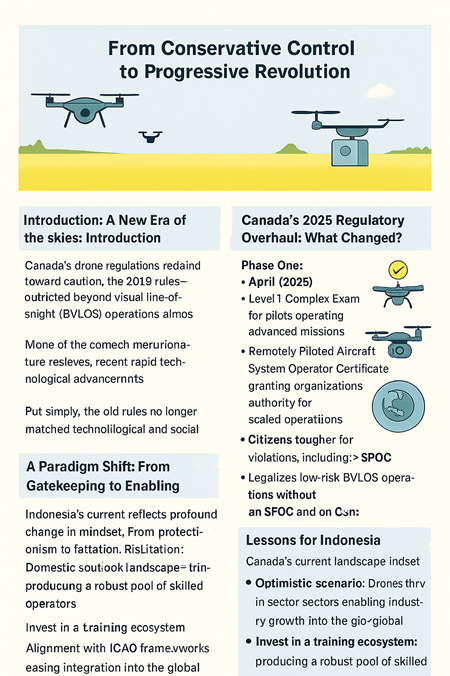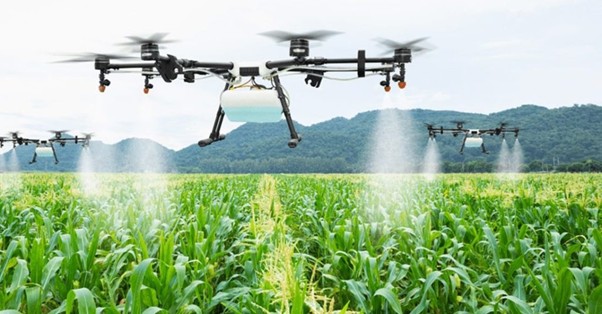Introduction: A New Era of the Skies
Picture a calm morning in rural Alberta. A medium-sized drone flies just above a golden wheat field, carrying multispectral sensors to assess soil fertility. A few kilometres away, another drone delivers urgent medical supplies to a remote village, once considered unreachable by land. None of this requires a burdensome special permit. Instead, the flights operate under standardized certifications introduced after Transport Canada’s sweeping regulatory reforms in 2025.
This is the new face of Canadian airspace. The latest drone regulations are more than technical directives; they represent the courage of a nation to balance innovation, safety, and public interest. The ripple effects of these reforms extend beyond Canada’s borders. Around the world—Indonesia included—governments are watching closely, evaluating what lessons can be drawn from Canada’s regulatory shift.

From Conservative Control to Progressive Revolution
Until recently, Canada’s drone regulations leaned toward caution. The 2019 rules—outlined in Canadian Aviation Regulations Part IX—restricted beyond visual line-of-sight (BVLOS) operations almost entirely. Companies and individuals were required to secure a Special Flight Operations Certificate (SFOC) for every BVLOS mission.
This process was designed with safety in mind but had unintended consequences. Many operators in energy, logistics, and agriculture grew frustrated with the bureaucracy. Applications often took weeks or months to process, and even then approvals were time-limited.
Meanwhile, drone technology advanced rapidly. Detect-and-avoid systems became commercially available. GPS navigation reached centimeter-level precision. Artificial intelligence enabled more autonomous flight paths. Industry needs grew louder: agriculture required efficient land monitoring, energy companies demanded safer inspection methods, and the COVID-19 pandemic spotlighted the life-saving potential of drone-based medical deliveries.
Put simply, the old rules no longer matched the technological and societal realities.
Canada’s 2025 Regulatory Overhaul: What Changed?
Recognizing the gap, Transport Canada introduced a two-phase reform in 2025.
Phase One (April 2025): Strengthening Competence and Oversight
Introduction of the Level 1 Complex Exam for pilots operating advanced missions.
Creation of the Remotely Piloted Aircraft System Operator Certificate (RPOC), granting organizations authority for scaled operations.
Raising the minimum pilot age for complex missions to 18, coupled with 20 hours of mandatory training and a supervised flight review.
Tougher penalties for violations, including fines up to CAD 15,000 for corporations.
Phase Two (November 2025): Expanding Operational Flexibility
Medium drones (25–150 kg) permitted without individual approvals.
Authorization of Extended Visual Line of Sight (EVLOS) operations using trained observers.
Introduction of “sheltered operations,” enabling low-altitude flights near vegetation or buildings with risk-mitigation measures.
Legalization of low-risk BVLOS operations without an SFOC, provided the operator holds an RPOC and the pilot passes the Level 1 Complex Exam.
For the first time, Canada declared BVLOS not an exception to be tightly policed but a normal, manageable feature of modern drone ecosystems.
A Paradigm Shift: From Gatekeeping to Enabling
Canada’s reform reflects a profound change in mindset:
From individual waivers to systemic certification
No longer must operators apply for mission-specific permits. Competency certification now serves as the gatekeeper.
From protectionism to facilitation
The focus is not merely on preventing risks but on enabling industry growth responsibly.
From a domestic outlook to global alignment
By adopting risk-based regulation, Canada aligned itself with European frameworks while surpassing the United States, where BVLOS still requires cumbersome waivers.
This repositioning places Canada among the world’s regulatory pioneers.
Economic and Social Impact
Economic dividends:
Agriculture: Precision mapping, pest management, and targeted fertilization lower costs and increase yields.
Energy: Inspections of pipelines, power lines, and wind turbines become faster and safer.
Logistics: Deliveries to remote communities become financially viable.
Creative industries: Film, media, and tourism benefit from easier access to complex aerial shots.
Social benefits:
Public services: Remote areas gain access to healthcare and emergency deliveries.
Employment: New jobs emerge for drone pilots, instructors, technicians, and data analysts.
Challenges: Privacy remains a sticking point, with citizens wary of aerial surveillance and unconsented data collection.
The message is clear: drone regulations are no longer an aviation niche. They touch livelihoods, economies, and public trust.
Canada in the Global Regulatory Landscape
United States (FAA): BVLOS still tied to waivers, frustrating innovators. Canada has overtaken its southern neighbor.
European Union (EASA): Operates on a risk-based framework. Canada borrowed elements but tailored them with the RPOC system.
Asia: Japan excels in drone logistics; Singapore advances in urban surveillance. Indonesia, by contrast, remains cautious, requiring manual approvals and restricting large swathes of airspace.
The result: Canada now stands shoulder-to-shoulder with Europe as a global leader.
Challenges Ahead for Canada
Despite the progress, hurdles remain:
Technology gaps: Many drones still lack reliable detect-and-avoid capabilities.
Human capital: Thousands of new instructors and training centers will be required.
Enforcement: Ensuring compliance across a vast territory is a daunting task.
Public acceptance: Concerns over noise, privacy, and security could spark resistance.
Canada’s experience shows that reform is not a finish line but the start of an ongoing balancing act.
Lessons for Indonesia
Indonesia’s Current Landscape
Indonesia’s drone rules are still restrictive. Operations often require clearance from the Ministry of Transportation and local authorities, particularly near airports, urban zones, or critical infrastructure. The process is manual, bureaucratic, and time-consuming.
As a result, potential remains largely untapped. Agriculture in Java and Sumatra could benefit from drone-based efficiency. Remote islands in Maluku and Papua could be served by drone logistics. Disaster management—whether in tsunamis, volcanic eruptions, or forest fires—could be transformed. Yet regulatory rigidity keeps these prospects dormant.
Lessons from Canada
Adopt risk-based classifications.
Like Canada, Indonesia could categorize operations into low, medium, and high risk. Low-risk BVLOS flights should be legalized without repetitive manual permits.
Shift from mission permits to operator certification.
Focus on whether operators and pilots are competent, rather than micromanaging every flight plan.
Invest in a training ecosystem.
National exams and standardized training could produce a robust pool of skilled operators.
Integrate drones into public services.
Imagine drones delivering vaccines to small islands, monitoring illegal fishing, or patrolling forest fires.
Engage internationally.
Aligning with ICAO frameworks and learning from Canada’s model would smooth integration into the global aviation system.
By implementing these measures, Indonesia could position itself as a Southeast Asian leader in drone innovation.
Indonesia’s Possible Futures: 2030–2035
Optimistic scenario: Drones become ubiquitous—from rural logistics to urban transport. Adopting Canadian-style reforms, Indonesia catalyzes its digital economy.
Moderate scenario: Drones thrive in select sectors like agriculture and energy but face limits in urban logistics due to social resistance.
Pessimistic scenario: Regulatory inertia persists, leaving Indonesia trailing neighbors like Singapore and Malaysia.
Which future materializes depends on decisions made in the coming years.
Conclusion: A Call to Action
Canada’s 2025 drone reforms are a global milestone. By legitimizing low-risk BVLOS and shifting focus from individual permits to competency-based certification, Canada has shown that safety and innovation can coexist.
For Indonesia, the lesson is urgent. As the world’s largest archipelagic nation, with logistical challenges and disaster risks unique in scale, drones should not be viewed as optional—but essential. Conservative rules may feel safe, but they risk locking Indonesia out of a transformative technology.
Indonesia must be bold: adopt risk-based frameworks, certify operators, cultivate training systems, and integrate drones into national development. In doing so, drones will not just be gadgets in the sky but a backbone of Indonesia’s future economy and public services.
If Canada can chart this course, Indonesia can too. The only question is whether Jakarta will move fast enough to seize the opportunity—or allow hesitation to ground its potential.

